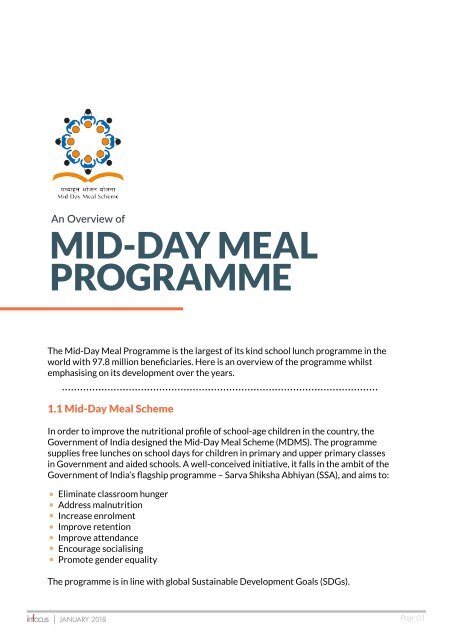Infocus 4 January 2018
You also want an ePaper? Increase the reach of your titles
YUMPU automatically turns print PDFs into web optimized ePapers that Google loves.
1.2 History<br />
In 1925, a Mid-Day Meal Programme was first<br />
introduced for disadvantaged children in Madras<br />
Municipal Corporation. By mid-1980s, three<br />
states – Gujarat, Kerala, and Tamil Nadu along<br />
with the Union Territory of Pondicherry had<br />
universalised a cooked meal programme with<br />
their own resources for children in the primary<br />
section. By 1990-91, the number of states<br />
implementing Mid-Day Meal Programmes was<br />
12.<br />
An Overview of<br />
MID-DAY MEAL<br />
PROGRAMME<br />
The Mid-Day Meal Programme is the largest of its kind school lunch programme in the<br />
world with 97.8 million beneficiaries. Here is an overview of the programme whilst<br />
emphasising on its development over the years.<br />
1.1 Mid-Day Meal Scheme<br />
In order to improve the nutritional profile of school-age children in the country, the<br />
Government of India designed the Mid-Day Meal Scheme (MDMS). The programme<br />
supplies free lunches on school days for children in primary and upper primary classes<br />
in Government and aided schools. A well-conceived initiative, it falls in the ambit of the<br />
Government of India’s flagship programme – Sarva Shiksha Abhiyan (SSA), and aims to:<br />
Eliminate classroom hunger<br />
Address malnutrition<br />
Increase enrolment<br />
Improve retention<br />
Improve attendance<br />
Encourage socialising<br />
Promote gender equality<br />
The programme is in line with global Sustainable Development Goals (SDGs).<br />
infocus | JANUARY <strong>2018</strong><br />
Page 01<br />
In 2001, ‘Right to Food’, a derived fundamental<br />
right which is enforceable by virtue of the<br />
constitutional remedy, was recognised. The<br />
Supreme Court of India on November 28, 2001<br />
passed an order directing the State Governments<br />
and Union Territories to implement the<br />
Mid-Day Meal Scheme. As per the scheme every<br />
child in every Government and Government<br />
assisted Primary School was to be provided a<br />
prepared mid-day meal. In 2002, the scheme was<br />
extended to cover children studying in Education<br />
Guarantee Scheme (EGS) and Alternative &<br />
Innovative Education (AIE) centres. Further<br />
amendments and inclusions have only boosted<br />
the extent of implementation of the Mid-Day<br />
Meal Programme.<br />
It is one of the most promising programmes to<br />
directly tackle classroom hunger and promote<br />
education. Enhancing enrolment, retention and<br />
attendance while simultaneously improving the<br />
nutritional levels among children has been the<br />
genesis for this programme. This Scheme has the<br />
potential to counter the three interconnected<br />
issues of illiteracy, hunger and poverty.<br />
Since 2001, when the Supreme Court of India<br />
formally mandated that cooked mid-day<br />
meal should be provided to every child at all<br />
government schools and government assisted<br />
primary schools, this programme has received<br />
much appreciation and impact on the classroom<br />
hunger, literacy and health, yet the nation as a<br />
whole has a long way to go. The Government<br />
of India and all State Governments have been<br />
constantly trying to improve this programme<br />
with new inclusions and improvement directives<br />
in the meal menu such as addition of fruit and<br />
milk in the menu.<br />
infocus | JANUARY <strong>2018</strong>


